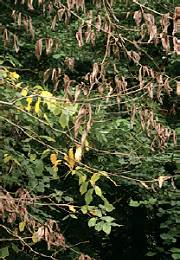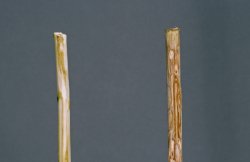 Dutch elm disease is one of the world’s most serious tree diseases. It is caused by the fungus Ophiostoma novo-ulmi, which invades and blocks the water-conducting systems of trees. This results in the wilting and death of the tree.
Dutch elm disease is one of the world’s most serious tree diseases. It is caused by the fungus Ophiostoma novo-ulmi, which invades and blocks the water-conducting systems of trees. This results in the wilting and death of the tree.
- Symptoms first appear in early summer
- Clusters of leaves turn yellow and wilt
- Leaves later turn brown and fall
- Twigs sometimes turn down to form ‘shepherd's crooks'
- Trees might display a mixture of healthy and diseased foliage and shoots
- Affected shoots die back from the tip
Diagnosis
 If you suspect that a Dutch Elm tree is diseased, select some live twigs that show symptoms. First peel back the bark of the twig: dark brown or purple longitudinal streaks in the outer wood indicate disease. You can also cut across a twig to examine the outer wood: a ring of dark brown staining indicates disease.
If you suspect that a Dutch Elm tree is diseased, select some live twigs that show symptoms. First peel back the bark of the twig: dark brown or purple longitudinal streaks in the outer wood indicate disease. You can also cut across a twig to examine the outer wood: a ring of dark brown staining indicates disease.
However, not all twigs will show brown streaking, especially in the branches of large trees.
